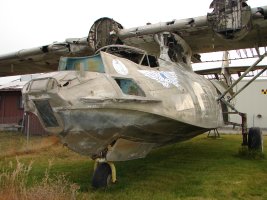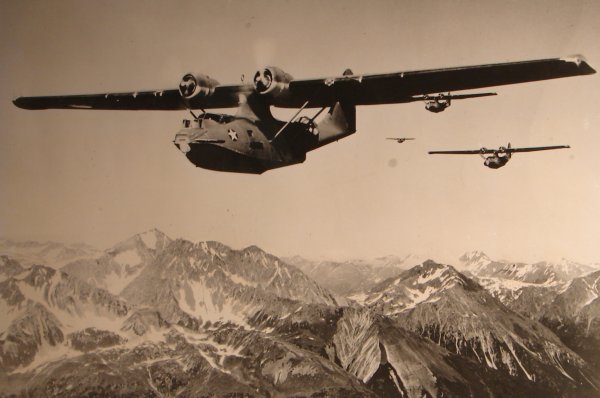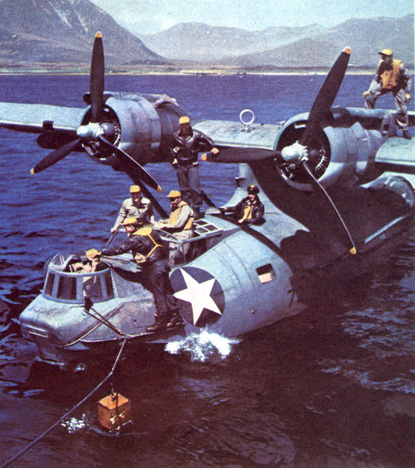PBY
What kind of aircraft is that huge beat up flying boat thingy with wheels?
The short answer is that it's a "PBY".
It is a Consolidated Aircraft design referred to as a "Catalina".
The designation "PBY" was determined in accordance with the U.S. Navy aircraft designation system of 1922; PB representing "Patrol Bomber" and Y being the code assigned to Consolidated Aircraft as its manufacturer.
The prototype Catalina first flew on March 28, 1935, the first production PBY Catalina was launched in San Diego Bay in 1936.
This aircraft is a Consolidated PBY-5A model manufactured by Canadian Vickers Limited. Since it's the first version built by Vickers, it's model number is "1" rather than "5-A", so it's designation is "PBV-1". Canadian Catalinas were named Canso by the Royal Canadian Air Force in accordance with contemporary British naming practice of naming seaplanes after coastal port towns, in this case for the town of Canso in Nova Scotia. The RAF in contrast used the Catalina name.
The PBY-5A model was manufactured from October 1941 through January 1945. It's features were: Hydraulically actuated, retractable tricycle landing gear, with main gear design based on one from the 1920s designed by Leroy Grumman, for amphibious operation. Introduced tail gun position, replaced bow single gun position with bow "eyeball" turret equipped with twin .30 machine guns (some later units), improved armor, self-sealing fuel tanks. Previous models were seaplanes without wheels.
The United States Army Air Forces and later the United States Air Force used the designation OA-10.
The OA-10 operated primarily for air-sea rescue work ("DUMBO" missions) with the USAAF's Emergency Rescue Squadrons throughout WWII and for several years thereafter. During the war, OA-10 crews rescued hundreds of downed fliers.
In July 1941, the Canadian government awarded Canadian Vickers Limited a contract to produce PBV-1 "Canso" amphibians (a version of the Consolidated PBY Catalina flying boat) for the Royal Canadian Air Force (RCAF). Many of the aircraft were delivered to the United States Navy (USN) as the PBV-1; also to the United States Army Air Forces (USAAF) as the OA-10A for rescue work.
What you called the plane depended on who was operating it, and where it was built.

| PBY vs F-22 | ||
| PBY | F-22 | |
| Length: | 63' 10" | 62' |
| Wingspan: | 104' | 44' |
| Empty weight: | 20,00 lbs | 43,00 lbs |
| Max weight: | 35,00 lbs | 85,00 lbs |
| Ferry Range: | 2,520 miles | 1,738 nm |
| Fuel Capacity: | 1,750 gallons | 3,050 gallons |
According to Wikipedia: The cockpit canopy of the Lockheed Martin F-22 Raptor jet fighter is made from a piece of high optical quality polycarbonate, and is the largest piece of its type formed in the world.
PBY
Engine fuel consumption at cruise = 28 gallons per hour
Two engines = 56 gallons per hour
1,750 gallons / 56 gallons per hour = 31 hours cruise time
At $5 per gallon = $8,750 for a fill-up and $280 per hour for gas
PBY compared to a Subaru Forester:
1,750 gallons x 28 MPG = 49,000 miles
At 12,000 miles per year = 4 years of driving
The "PBY" on display here was built in Canada by the Canadian Vickers company. It had hydraulically actuated tricycle landing gear for amphibious operations. This model had a bow turret with twin 30 caliber machine guns and self sealing fuel tanks. During WWII it was used in anti-submarine patrol, observation, search and rescue. This model of PBY cruised at 125 knots, a ceiling of 15,800 feet with 2 engines rated at 1200 hp each. It carried a crew of 8.
While operating with the 10th Rescue Squadron in 1947 at Elmendorf Air Force Base, the AAM Catalina landed at Dago Lake on the Alaska Peninsula. It was an emergency landing caused by engine failure. The lake was too shallow for the plane to receive repairs and then take off. Declared government surplus, it was purchased by the R.S. Richards family, stripped of parts and left at Dago Lake until 1984.
A gigantic recovery project conducted by the National Guard and the AAM volunteers finally brought the huge amphibian to the museum utilizing two Alaska helicopter operations in 1984 & 1987. This operation was captured in a DVD called "The Queen of Dago Lake".




.jpg)




